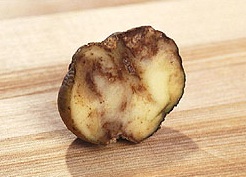
Features
Production
Research
Advancement toward controlling late blight
November 22, 2010 By Fruit & Vegetable
 November 22, 2010 –
November 22, 2010 –
Scientists are reporting a key advance toward development of a way to combat
the terrible plant diseases that caused the Irish potato famine and still
inflict billions of dollars of damage to crops each year around the world.
@font-face {
font-family: “Verdana”;
}p.MsoNormal, li.MsoNormal, div.MsoNormal { margin: 0in 0in 0.0001pt; font-size: 16pt; font-family: Times; }div.Section1 { page: Section1; }November 22, 2010 –
Scientists are reporting a key advance toward development of a way to combat
the terrible plant diseases that caused the Irish potato famine and still
inflict billions of dollars of damage to crops each year around the world.
Their study appears in
American Chemical Society’s journal Organic Letters.
Teck-Peng Loh and
colleagues point out that the Phytophthora fungi cause extensive damage to food
crops such as potatoes and soybeans as well as to ornamental plants like
azaleas and rhododendrons.
 |
|
Still difficult to control
despite the use of modern pesticides, the fungus continues to cause $6 billion
in damage to global potato crops annually. Scientists, however, have isolated a
key hormone, alpha-1, that allows Phytophthora to reproduce. The hormone exists
in several different forms, and a synthetic version of the most biologically
active form could provide the basis for developing a way to control the fungus
and reduce its threat, the scientists suggest.
They describe an advance
toward this goal, the synthesis of a particularly active form of the mating
hormone called (3R,7R,11R,15R)-hormone alpha-1. The scientists also showed that
they could make relatively large quantities of the hormone. The advance could
open the door to an effective method to fight this ancient scourge, they
suggest.
Print this page